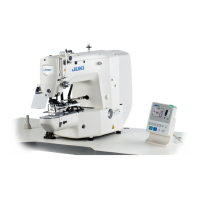70
Trouble Cause Corrective measures Page
5. Stitch skipping often
occurs.
The motions of the needle
and shuttle are not properly
synchronized.
The clearance between the
needle and shuttle is too
large.
The needle is bent.
The driver excessively
bends the needle.
Correct the positions of the needle and
shuttle.
Correct the positions of the needle and
shuttle.
Replace the bent needle.
Correctly position the driver.
45
45
13
45
6. The needle thread
comes out on the
wrong side of the ma-
terial.
The needle thread tension
is not high enough.
The tension release mech-
anism fails to work properly.
The needle thread after
thread trimming is too long.
Number of stitches is too
few.
When sewing length is
short (End of needle thread
protrudes on the wrong side
of sewing product.)
Number of stitches is too
few.
Increase the needle thread tension.
Check whether or not the tension disc
No. 2 is released during bar-tracking.
Increase the tension of the thread ten-
sion controller No. 1.
Turn OFF the thread clamp.
Turn OFF the thread clamp.
Use the lower plate, the hole of which
is larger than the presser.
15
15
7. Threads break at time
of thread trimming.
The moving knife has been
improperly position.
Correct the position of the moving
knife.
46
8. The thread clamp is
entangled with needle
thread.
The needle thread at the
sewing start is too long.
Tighten thread tension controller No. 1
and make the length of needle thread
33 to 36 mm.
9. Uneven length of the
needle thread
The tension of thread take-
up spring is too low.
Increase the tension of the thread
take-up spring.
10.
The length of needle
thread does not become
short.
The tension of thread ten-
sion controller No. 1 is too
low.
The tension of thread take-
up spring is too high.
The tension of thread take-
up spring is too low and
motion is unstable.
Increase the tension of thread tension
controller No. 1.
Decrease the tension of thread take-
up spring.
Increase the tension of thread take-
up spring and lengthen the stroke as
well.
11.
The knotting section of
bobbin thread at 2nd
stitch at the sewing
start appears on the
right side.
Idling of bobbin is large.
The bobbin thread tension
is too low.
The needle thread tension
at 1st stitch is too high.
Adjust the position of the moving
knife.
Increase the bobbin thread tension.
Decrease the needle thread tension
at 1st stitch.
Turn OFF the thread clamp.

